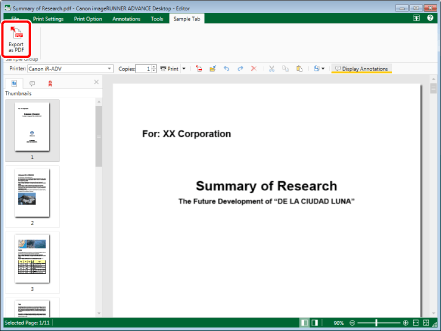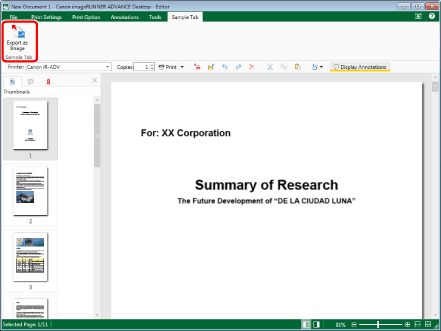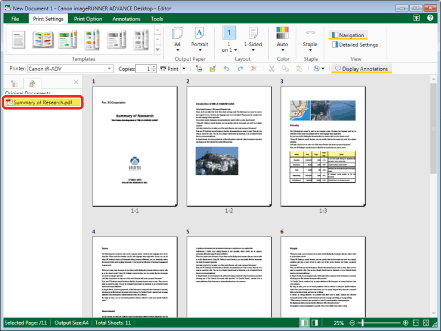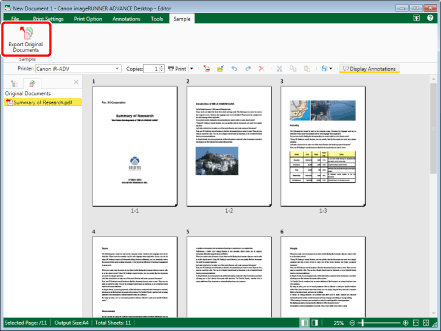Exporting a Document Edited with Desktop Editor to Therefore
Documents edited with Desktop Editor can be exported to Therefore in the PDF format (*.pdf).
You can also export (save) the original documents stored in an IWB document to Therefore.
|
NOTE
|
|
For information on exporting documents edited with Desktop Editor to a library or Windows Folder, see the following.
Exporting Documents in the PDF Format (User's Guide)
Creating TIFF Documents/JPEG Documents with Desktop Editor (User's Guide)
Exporting Original Documents (User's Guide)
|
Exporting to Therefore in the PDF Format
|
NOTE
|
|
You can specify the page range to export when exporting.
When exporting in the PDF format, the layout settings and the blank side of a 2-sided printing/booklet printing configured in Desktop Editor (such as [Output Size], [Output Paper Orientation], [Page Layout], and [Enlarge/Reduce Original Page]) are applied to the PDF document. If the following are set to be printed, they are also reflected in the PDF document.
Annotations
Headers/Footers
The tab section of the tab paper
Watermarks
|
1.
Click  (Export as PDF) on the ribbon.
(Export as PDF) on the ribbon.
 (Export as PDF) on the ribbon.
(Export as PDF) on the ribbon.Or, select the [File] menu > [Export as PDF].

The [Select Export Destination] dialog box is displayed.
|
NOTE
|
|
If commands are not displayed on the ribbon of Desktop Editor, see the following to display them.
Adding Commands to Ribbons (User's Guide)
This operation can also be performed with the tool buttons on the toolbar. If tool buttons are not displayed on the toolbar of Desktop Editor, see the following to display them.
Setting Buttons on Toolbars (User's Guide)
Lists of Ribbon Commands/Toolbars (User's Guide)
|
2.
Select [Therefore], and click [OK].
The [Export as PDF] dialog box is displayed.
3.
Specify [Document Name].
4.
To specify the pages to export, select [Print Pages] in [Export Range] and specify the page number in the displayed [Specify Range].
You can use the following formats to specify a range of page numbers.
When exporting from page "a" to the last page: a-
("a" indicates the page number to start exporting)
When exporting from the first page to page "b": -b
("b" indicates the page number to end exporting)
When exporting continuous pages: a-b
("a" and "b" indicate the page numbers to start and end exporting respectively)
When exporting discontinuous pages: c,d
("c" and "d" indicate the individual page numbers to export, separated by commas)
|
NOTE
|
|
The entry order of [Specify Range] is not the order of pages of the document to be exported. Even when you enter "1,2" or "2,1", pages are exported in the order "1,2".
[Print Pages] is not available in [Export Range], when [Booklet Printing] and [Sheet for Insertion] are selected in [Print Style].
If 2-sided printing is set, both sides are exported even if only one side of the page to print is specified in the range.
|
5.
If you want to export with advanced settings specified, click [Detailed Settings].
The [Detailed Settings for PDF Document] dialog box is displayed.
6.
Configure the advanced settings of the PDF document, then click [OK].
For more information on the [Detailed Settings for PDF Document] dialog box, see the following.
Exporting Documents in the PDF Format (User's Guide)
The [Export as PDF] dialog box is displayed again.
When a password to open the document is set, the [Confirm Document Open Password] dialog box is displayed. In this case, enter the same password you have entered in [Document Open Password], and click [OK].
When printing or editing the document is restricted, the [Confirm Permissions Password] dialog box is displayed. In this case, enter the same password you have entered in [Change Permissions Password], and click [OK].
When you click [OK] after entering all the passwords again, the [Export as PDF] dialog box is displayed again.
7.
Click [Save].
8.
If a dialog box is displayed, enter the user name and password.
For more information, see the instruction manual for Therefore.
The document is saved to Therefore as a PDF document.
|
NOTE
|
|
A dialog box may be displayed if you close Desktop Editor without saving the changes after editing a document in Therefore.
|
Exporting to Therefore in TIFF Format or JPEG Format
|
IMPORTANT
|
|
If a document is converted into a TIFF/JPEG document, annotations containing unrenderable characters are deleted.
|
|
NOTE
|
|
The print settings specified for the document are not reflected in the exported TIFF/JPEG document.
A document with multiple pages is exported as a single TIFF document.
A document with multiple pages is exported as a separate JPEG document for each page.
|
1.
Click  (Export as Image) on the ribbon.
(Export as Image) on the ribbon.
 (Export as Image) on the ribbon.
(Export as Image) on the ribbon.Or, select [File] menu > [Export as Image].

The [Select Export Destination] dialog box is displayed.
|
NOTE
|
|
If commands are not displayed on the ribbon of Desktop Browser, see the following to display them.
Adding Commands to Ribbons (User's Guide)
This operation can also be performed with the tool buttons on the toolbar. If tool buttons are not displayed on the toolbar of Desktop Browser, see the following to display them.
Setting Buttons on Toolbars (User's Guide)
Lists of Ribbon Commands/Toolbars (User's Guide)
|
2.
Select [Therefore], and click [OK].
The [Export as Image] dialog box is displayed.
3.
Specify [Document Name].
4.
Select [TIFF File (*.tiff;*.tif)] or [JPEG File (*.jpg;*.jpeg)] in [Document Type].
5.
To specify the pages to export, select [Original Pages] in [Export Range] and specify the page number in the displayed [Specify Range].
You can use the following formats to specify a range of page numbers.
When exporting from page "a" to the last page: a
("a" indicates the page number to start exporting)
When exporting from the first page to page "b": b
("b" indicates the page number to end exporting)
When exporting continuous pages: a-b
("a" and "b" indicate the page numbers to start and end exporting respectively)
When exporting discontinuous pages: c,d
("c" and "d" indicate the individual page numbers to export, separated by commas)
|
NOTE
|
|
When exporting a document in the TIFF format, the entry order of [Specify Range] is not the order of pages of the TIFF document to be exported. Even when you enter "1,2" or "2,1", pages of the TIFF document are exported in the order "1,2".
When exporting a document with multiple pages in the JPEG format, the name of the exported JPEG document is the name of the document with "_serial number" appended. If you specify a page range to export, the page numbers of the specified range are used as the serial number. The serial numbers have the same number of digits as the number of pages of the original document. If a document with the same name exists in the destination folder, "(2)" is appended to the document name.
|
6.
If you want to export with advanced settings specified, click [Detailed Settings].
When exporting a document in the TIFF format, the [Convert to TIFF Document] dialog box is displayed.
When exporting a document in the JPEG format, the [Convert to JPEG Document] dialog box is displayed.
7.
Configure the advanced settings of the TIFF document or the JPEG document, then click [OK].
For more information on the [Convert to TIFF Document] dialog box and [Convert to JPEG Document] dialog box, see the following.
Creating TIFF Documents/JPEG Documents with Desktop Editor (User's Guide)
The [Export as Image] dialog box is displayed again.
8.
Click [Save].
9.
If a dialog box is displayed, enter the user name and password.
For more information, see the instruction manual for Therefore.
The document is saved in Therefore in the TIFF or JPEG format.
|
NOTE
|
|
A dialog box may be displayed if you close Desktop Editor without saving the changes after editing a document in Therefore.
|
Exporting Original Documents to Therefore
This section describes how to export (save) the original documents stored in an IWB document to Therefore.
|
NOTE
|
|
Exporting a document may fail when the free capacity of the target disk is insufficient. When exporting a document with a large file size, be sure to confirm that the target disk has an enough free space remaining in advance.
|
1.
Select the original documents to export from the [Original Documents] tab on the Navigation Window.

|
NOTE
|
|
If the [Original Documents] tab is not displayed on the Navigation Window, see the following to display it.
Displaying/Hiding the Navigation Window (User's Guide)
|
2.
Click  (Export Original Documents) on the ribbon.
(Export Original Documents) on the ribbon.
 (Export Original Documents) on the ribbon.
(Export Original Documents) on the ribbon.Or, right-click and select [Export Original Documents].

The [Select Export Destination] dialog box is displayed.
|
NOTE
|
|
If commands are not displayed on the ribbon of Desktop Editor, see the following to display them.
Adding Commands to Ribbons (User's Guide)
This operation can also be performed with the tool buttons on the toolbar. If tool buttons are not displayed on the toolbar of Desktop Editor, see the following to display them.
Setting Buttons on Toolbars (User's Guide)
Lists of Ribbon Commands/Toolbars (User's Guide)
|
3.
Select [Therefore], and click [OK].
A dialog box is displayed.
4.
Enter the user name and password.
For more information, see the instruction manual for Therefore.
Exporting starts.
|
NOTE
|
|
A dialog box may be displayed if you close Desktop Editor without saving the changes after editing a document in Therefore.
|